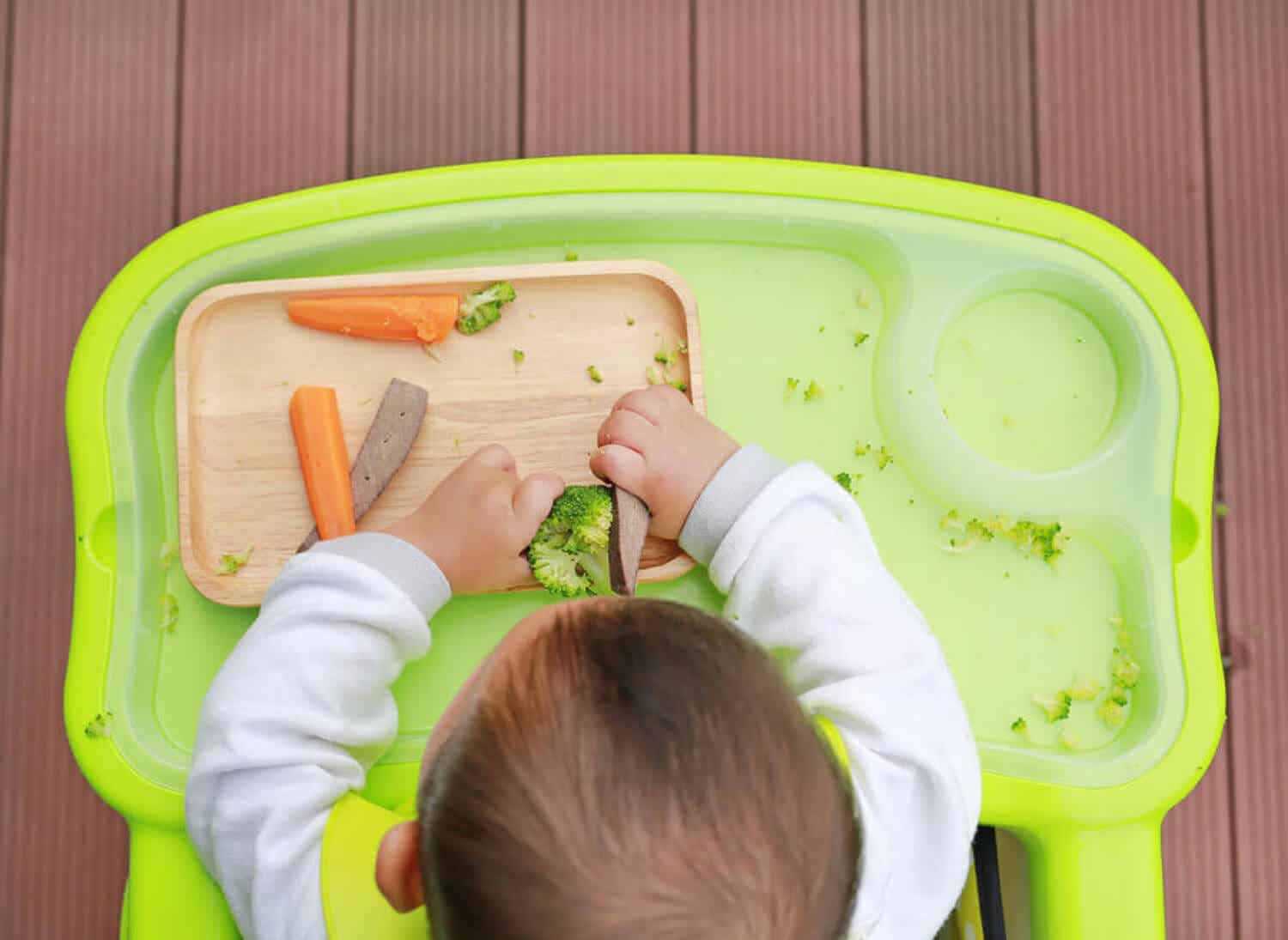How Do Children Learn to Chew?

The moment children learn to chew is a time of exploration. Children also go through different changes in their eating habits, and adults should monitor the process.
Sometimes, incorporating solid food into your baby’s diet can be quite difficult. The change in texture and flavors, like going from liquid milk to more solid purées, may take some adaptation time and patience.
Therefore, you should include solid food in your baby’s diet in a gradual and progressive manner. This way, your child will get used to these new habits more easily. Keep reading to learn how children learn to chew, and what adults can do to make this process easier.
Developing chewing skills
First, children recognize food, then they learn to choose it, and finally, they learn to chew. Swallowing, digestion and excretion are the actions that complete the learning cycle.
You could say that babies learn to chew in a spontaneous and automatic way. However, learning to eat solid food is a process in which adults play a very important role.
In fact, recognizing, choosing and accepting food is a process that involves the senses and memory. Babies learn to chew through the feeling that food causes in them, and through observation. It’s also very important to be aware of the fact that children learn to chew by imitating the adults around them.

During the chewing process, different dental elements participate, such as the upper jaw bone, the lips, the cheeks, the tongue, the palate and the temporomandibular joint. The chewing muscles are in charge of making the area move, allowing the jaw to open and close.
When do children learn to chew?
After they turn six months old, babies start eating solid food. By doing this in a gradual manner, children start learning the process.
“Exclusive breastfeeding for the first 6 months of life; and introduction of nutritionally-adequate and safe complementary (solid) foods at 6 months together with continued breastfeeding up to two years of age and beyond.”
– World Health Organization (WHO) recommendation –
After babies are 6 months old and until they’re 1 year old, you should give them small pieces of soft food. Once they’re 1 year old, you can start giving them more solid food. After their milk teeth start erupting, they can try different textures, which will also be beneficial for their gum pain.
Parents should always monitor their children’s eating, in order to prevent them from choking. When they eat together, children also have the chance to imitate their parents’ actions.
Remember that pediatricians are the ones who can truly help you regarding your baby’s first foods. It’s important to clear up all your questions and concerns, so you can choose the best way to feed your baby.
Why it’s important that your children learn to chew
If your children learn to chew, they won’t choke on food. Furthermore, there are some benefits children obtain from chewing:
- Promotes facial bones and muscle development.
- Protects the mouth: incorporating new textures helps the teeth clean themselves. On the other hand, soft food, like purées and milk, stick to the teeth and may cause cavities.
- Stimulates digestion: it produces saliva secretion, facilitates nutrient absorption, causes a sense of fulness and reduces gastritis and reflux.
- Reduces stress in children.
Is it necessary to teach children to chew?
As we’ve mentioned before, babies learn to chew in a progressive way. It doesn’t happen over night. Parents should also incorporate solid food gradually, because practice is what makes children learn.
As time goes by, you should incorporate bigger pieces of food and more complex textures. For example, you can crush the purées with a fork instead of using a blender so children can identify those pieces of food.
It’s important to incorporate different foods gradually, from soft to solid meals. As a result, this will stimulate mouth receptors, fortifying facial muscles and helping children acquire new skills.
If you think your baby is having a hard time learning how to chew, you should visit their pediatrician. They might suffer from structural or functional alterations, or they may be exposed to different family traditions, which might make this process more difficult for them.
Sometimes, they need to visit a speech therapist. This specialist can evaluate the babies’ chewing functions and help improve them.

More tips to promote proper ways to chew
As we’ve already mentioned, offering babies different textures gradually will help them learn how to chew properly. However, there are certain practices that can be helpful during the process:
- Remove distractions: avoid watching TV when it’s time to eat. Spend this moment with your family and pay attention to your baby’s development.
- Incorporate new food: giving them new textures every week can be quite fun for babies. You should ask the pediatrician about the type of food they can eat.
- Eat the same thing your child is eating: unless you’re eating something too solid or dangerous for their health, eating the same thing may encourage children to chew.
- Eat together: being at the table with the adults can be quite motivating. Exaggerate mouth movements so they can imitate you.
- Let them eat on their own: practicing their skills will make them feel more independent. When they use their hands, they also practice their motor skills and coordination.
- Be patient: this is a learning period. Therefore, it requires practice, time, patience and understanding. Try not to become anxious, and don’t make comparisons. If children don’t want to eat solid food, try not to insist. Maybe it’s too soon, and you can try again the following week.
- Avoid dangerous food: don’t give them hard or big pieces of food. Furthermore, you should avoid ultra-processed food, salt and sugar.
Finally, remember that once children become curious about something, they want to learn how to do it. Also, each child learns at their own rhythm, and respecting the process will make them feel motivated.
The moment children learn to chew is a time of exploration. Children also go through different changes in their eating habits, and adults should monitor the process.
Sometimes, incorporating solid food into your baby’s diet can be quite difficult. The change in texture and flavors, like going from liquid milk to more solid purées, may take some adaptation time and patience.
Therefore, you should include solid food in your baby’s diet in a gradual and progressive manner. This way, your child will get used to these new habits more easily. Keep reading to learn how children learn to chew, and what adults can do to make this process easier.
Developing chewing skills
First, children recognize food, then they learn to choose it, and finally, they learn to chew. Swallowing, digestion and excretion are the actions that complete the learning cycle.
You could say that babies learn to chew in a spontaneous and automatic way. However, learning to eat solid food is a process in which adults play a very important role.
In fact, recognizing, choosing and accepting food is a process that involves the senses and memory. Babies learn to chew through the feeling that food causes in them, and through observation. It’s also very important to be aware of the fact that children learn to chew by imitating the adults around them.

During the chewing process, different dental elements participate, such as the upper jaw bone, the lips, the cheeks, the tongue, the palate and the temporomandibular joint. The chewing muscles are in charge of making the area move, allowing the jaw to open and close.
When do children learn to chew?
After they turn six months old, babies start eating solid food. By doing this in a gradual manner, children start learning the process.
“Exclusive breastfeeding for the first 6 months of life; and introduction of nutritionally-adequate and safe complementary (solid) foods at 6 months together with continued breastfeeding up to two years of age and beyond.”
– World Health Organization (WHO) recommendation –
After babies are 6 months old and until they’re 1 year old, you should give them small pieces of soft food. Once they’re 1 year old, you can start giving them more solid food. After their milk teeth start erupting, they can try different textures, which will also be beneficial for their gum pain.
Parents should always monitor their children’s eating, in order to prevent them from choking. When they eat together, children also have the chance to imitate their parents’ actions.
Remember that pediatricians are the ones who can truly help you regarding your baby’s first foods. It’s important to clear up all your questions and concerns, so you can choose the best way to feed your baby.
Why it’s important that your children learn to chew
If your children learn to chew, they won’t choke on food. Furthermore, there are some benefits children obtain from chewing:
- Promotes facial bones and muscle development.
- Protects the mouth: incorporating new textures helps the teeth clean themselves. On the other hand, soft food, like purées and milk, stick to the teeth and may cause cavities.
- Stimulates digestion: it produces saliva secretion, facilitates nutrient absorption, causes a sense of fulness and reduces gastritis and reflux.
- Reduces stress in children.
Is it necessary to teach children to chew?
As we’ve mentioned before, babies learn to chew in a progressive way. It doesn’t happen over night. Parents should also incorporate solid food gradually, because practice is what makes children learn.
As time goes by, you should incorporate bigger pieces of food and more complex textures. For example, you can crush the purées with a fork instead of using a blender so children can identify those pieces of food.
It’s important to incorporate different foods gradually, from soft to solid meals. As a result, this will stimulate mouth receptors, fortifying facial muscles and helping children acquire new skills.
If you think your baby is having a hard time learning how to chew, you should visit their pediatrician. They might suffer from structural or functional alterations, or they may be exposed to different family traditions, which might make this process more difficult for them.
Sometimes, they need to visit a speech therapist. This specialist can evaluate the babies’ chewing functions and help improve them.

More tips to promote proper ways to chew
As we’ve already mentioned, offering babies different textures gradually will help them learn how to chew properly. However, there are certain practices that can be helpful during the process:
- Remove distractions: avoid watching TV when it’s time to eat. Spend this moment with your family and pay attention to your baby’s development.
- Incorporate new food: giving them new textures every week can be quite fun for babies. You should ask the pediatrician about the type of food they can eat.
- Eat the same thing your child is eating: unless you’re eating something too solid or dangerous for their health, eating the same thing may encourage children to chew.
- Eat together: being at the table with the adults can be quite motivating. Exaggerate mouth movements so they can imitate you.
- Let them eat on their own: practicing their skills will make them feel more independent. When they use their hands, they also practice their motor skills and coordination.
- Be patient: this is a learning period. Therefore, it requires practice, time, patience and understanding. Try not to become anxious, and don’t make comparisons. If children don’t want to eat solid food, try not to insist. Maybe it’s too soon, and you can try again the following week.
- Avoid dangerous food: don’t give them hard or big pieces of food. Furthermore, you should avoid ultra-processed food, salt and sugar.
Finally, remember that once children become curious about something, they want to learn how to do it. Also, each child learns at their own rhythm, and respecting the process will make them feel motivated.
All cited sources were thoroughly reviewed by our team to ensure their quality, reliability, currency, and validity. The bibliography of this article was considered reliable and of academic or scientific accuracy.
- Pinto, José M., Daniela B. Chávez, and Catalina Navarrete. “Salud bucal en el primer año de vida. Revisión de la literatura y protocolo de atención odontológica al bebé.” (2018).
- DE, CON EL APOYO. “TEXTURAS EVOLUTIVAS EN LA INTRODUCCIÓN DE NUEVOS ALIMENTOS.”
- Ortigosa-Pezonaga, Berta. “Nutrición Humana y Dietética.” Rev Esp Nutr Hum Diet 23.2 (2019): 104-122.
- Gutiérrez, Gema. “Baby-led weaning: alimentación complementaria a demanda. Una revisión bibliográfica.” NURE investigación: Revista Científica de enfermería 102 (2019): 4.
- Zaragoza Molinés, Loreto, and Carmen Tosat Mancho. “Baby Led Weaning: Un enfoque de alimentación complementaria dirigida por el bebé. Revisión bibliográfica.”
- Cuadros-Mendoza, Carlos Augusto, et al. “Actualidades en alimentación complementaria.” Acta pediátrica de México 38.3 (2017): 182-201.
- Manrique, Marta Vega Velasco. “Alimentación complementaria guiada por el bebé: respetando sus ritmos y apoyando su aprendizaje.” Medicina naturista 8.2 (2014): 64-72.
- CORREA, JOSÉ ZAMBRANO. EDAD DE INICIO, MOTIVOS Y PATRÓN ALIMENTARIO DE LA ALIMENTACIÓN COMPLEMENTARIA EN LACTANTES DE 4 A 7 MESES DE EDAD DEL CENTRO DE SALUD LA TULPUNA, ENERO Y FEBRERO DEL 2017. Diss. UNIVERSIDAD NACIONAL DE CAJAMARCA, 2017.
This text is provided for informational purposes only and does not replace consultation with a professional. If in doubt, consult your specialist.








